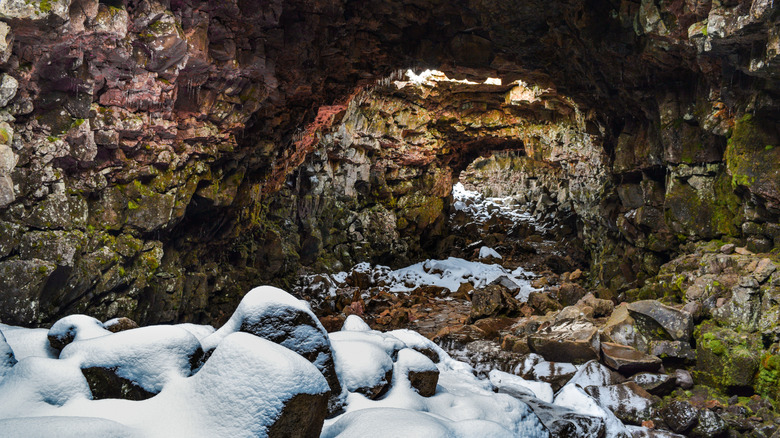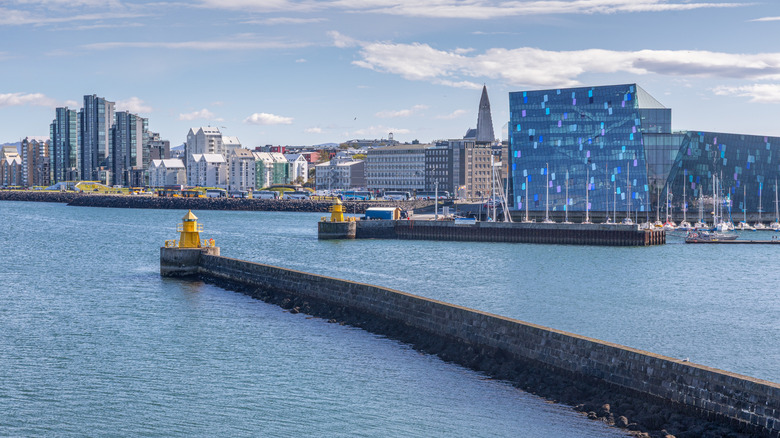One Of Rick Steves' Most Unforgettable Experiences In Iceland Will Blow You Away
If there's one thing Rick Steves knows, its unforgettable travel experiences. The travel blogger and television host is known around the world for his helpful guidance and tips when it comes to exploring, particularly in Europe. He is always ready to share his adventures, but he said that one of his most unforgettable travel experiences came while hiking a dormant volcano near Iceland's capital city.
On his website, Steves tells the story of venturing to the Þríhnúkagígur volcano. This ancient volcano near Reykjavík, Iceland, last erupted 4,500 years ago. Today, it is the only accessible lava chamber on Earth. It was in the railroad tunnel-sized lava tube that Steves witnessed "subtle lighting [that] brings out the tube's soft colors and fanciful features." He also adds that complete and total darkness surrounds visitors here when the guide flips off the lights.
Steves points to two different experiences to access the dormant volcano. The more expensive "Inside the Volcano" tour will literally drop guests via a lift system into the crater of the volcano before exploring the massive chamber below. It also includes a guided hike to and from the volcano. Another less expensive option is the "Lava Tunnel" tour. The tunnel, called Raufarhólshellir, is part of a different lava tube stretching nearly 4,500 feet. Both are accessible along Iceland's Ring Road, which Steves called "Europe's best road trip."
Volcanoes, glaciers, and wildlife await guests in Iceland
Iceland is home to more than 130 volcanoes, 30 or so of which are deemed active. But that doesn't mean exploring the once-full lava tubes is a choice experience for every tourist. Fortunately, there is no shortage of unforgettable experiences on this island nation. Its volcanoes are surrounded by glaciers, which cover nearly 11% of Iceland and lend to its appropriate nickname as the "land of ice and fire."
With 269 named glaciers in Iceland, Rick Steves points to one he considers among the most easily accessible. Sólheimajökull is a glacier on Iceland's South Coast. Here, day tours are available all year long through multiple companies and can last anywhere from a few hours to all-day adventures. Throughout the tours, keen-eyed guests will likely spot a myriad of Arctic wildlife species.
A number of different whale species thrive in Icelandic waters, and tours are available for up-close experiences. Arctic foxes are the only native land mammal in Iceland and usually sports white, brown, or light blue fur. Another popular animal in Iceland, especially in the spring and summer, is the puffin. Nearly 10 million of these birds nest along Iceland's seaside cliffs. It's recommended to keep a safe distance from any wild animal you may encounter during your Iceland adventure, including in one of Europe's most stunning national parks, Vatnajökull National Park.
Iceland's capital is the country's major access hub
The island nation of Iceland covers nearly 40,000 square miles to explore and boasts more than 3,000 miles of coastline. Many visitors here choose to find accommodations in Reykjavík on the island's west coast. Most locals live here as well, with more than half of Iceland's population calling this capital city home.
Keflavík International Airport (KEF) is just 30 miles outside of Reykjavík and welcomes roughly 20 airlines from Europe and North America throughout the year. The airport offers car rentals as well as flight connections to Reykjavík Airport (RKV), just outside of the city. The much smaller Reykjavík Airport is considered the country's domestic flight hub. This hub offers flights to four other domestic airports throughout Iceland, making the beauty and diversity of the Iceland experience more accessible.
When visiting Iceland, it's important to be flexible with your plans and clothing, since challenging weather can always make an impact. The warmer gulf currents here can bring warmer-than-expected days in Iceland. But when that warm air collides with colder Arctic air, storms can form and appear suddenly. It's one reason why wind makes Iceland much more dangerous than tourists may realize, according to Rick Steves.


